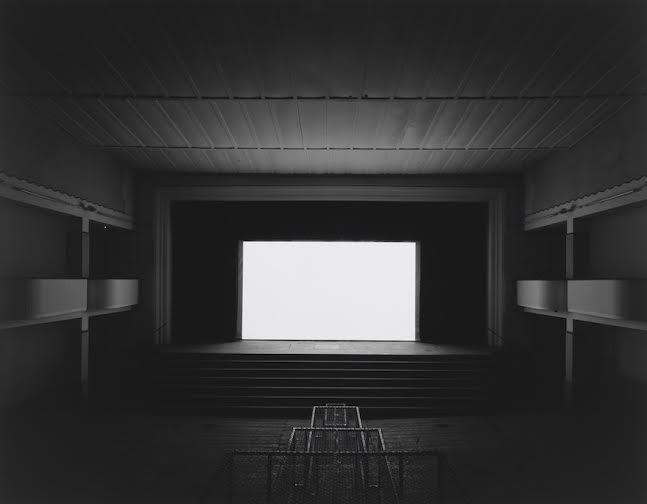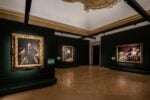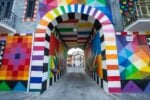Hiroshi Sugimoto

Doppio appuntamento in Toscana: Castello di Ama per l’Arte contemporanea e Galleria Continua di San Gimignano / Beijing / Les Moulins hanno il piacere di accogliere uno dei più autorevoli interpreti della fotografia contemporanea, l’artista giapponese Hiroshi Sugimoto.
Comunicato stampa
Doppio appuntamento sabato 18 ottobre in Toscana: Castello di Ama per l’Arte contemporanea e Galleria Continua di San Gimignano / Beijing / Les Moulins hanno il piacere di accogliere uno dei più autorevoli interpreti della fotografia contemporanea, l’artista giapponese Hiroshi Sugimoto.
Dal 1999 il sodalizio tra Marco Pallanti e Lorenza Sebasti - appassionati collezionisti e proprietari della tenuta vitivinicola Castello di Ama - e Galleria Continua di San Gimignano / Beijing / Les Moulins, ha dato vita ad un progetto artistico-culturale che ha visto artisti di fama internazionale realizzare opere site specific in permanenza per il borgo di Ama, un piccolo gioiello di origini medievali incastonato tra le colline nel cuore del Chianti.
Castello di Ama per l’Arte contemporanea si arricchisce di un nuovo contibuto artistico, “Confession of Zero”, installazione che Hiroshi Sugimoto concepisce appositamante per la Collezione e che colloca all’interno della cappella settecentesca di Villa Ricucci. Realizzata in collaborazione con Galleria Continua, l’opera riflette sul concetto di assenza e sul mistero dell’esistenza.
In occasione dell’opening saranno visitabili anche le opere site specific realizzate ad Ama negli anni precedenti da Michelangelo Pistoletto, Daniel Buren, Giulio Paolini, Kendell Geers, Anish Kapoor, Chen Zhen, Carlos Garaicoa, Nedko Solakov, Cristina Iglesias, Louise Bourgeois, Ilya e Emilia Kabakov, Pascale Marthine Tayou.
Negli spazi espositivi di Galleria Continua Hiroshi Sugimoto presenta alcune foto inedite della serie “Theaters”, tra queste anche “Cinema Teatro Nuovo” (2014) che ritrae l’ex-cinema teatro di San Gimignano dove ha sede la galleria. Immagini quasi surreali in cui il tempo che passa, racchiuso a forza in una dimensione che non gli appartiene, si tramuta in luce che scava l'oscurità portando delicatamente a galla gli elementi della scena circostante.
Le prime fotografie di questa serie l’artista le realizza a partire dal 1978 scattando foto all'interno di teatri americani degli anni Venti e Trenta convertiti in sale cinematografiche, come il Radio City Music Hall di New York. L’idea è quella di condensare il corso del tempo e la percezione dello spazio in un singolo momento, uniformando il tempo di esposizione a quello della durata della proiezione del film. Così Sugimoto racconta l’illuminazione che lo portò alla creazione di questa serie: “Una sera ebbi una specie di allucinazione. Il botta-e-risposta interiore che seguì questa visione fu una cosa del tipo: "è possibile immortalare un intero film in un singolo fotogramma? E cosa otterrei?"; la risposta fu: "nient'altro che un rettangolo luminoso". Mi misi immediatamente all'opera per materializzare l'idea. Camuffato da turista, entrai in un cinema di seconda categoria dell'East Village di New York portando con me una fotocamera di grande formato. Non appena il film ebbe inizio, azionai l'otturatore con il diaframma alla massima apertura; due ore dopo, alla fine del film, chiusi l'otturatore. La sera stessa sviluppai la pellicola: la mia visione era lì, di fronte ai miei occhi”.
Hiroshi Sugimoto nasce a Tokyo nel 1948. Nel 1970 si laurea alla Saint Paul’s University di Tokyo e successivamente nel 1974, all’Art Center College of Design di Los Angeles. In quello stesso anno di trasferisce a New York, città dove tutt’oggi vive e lavora. Figura poliedrica, ha sviluppato la sua pratica artistica principalmente attraverso la fotografia, associata talvolta a oggetti scultorei, architetture e allestimenti espositivi sperimentali. Le sue indagini fotografiche rivolte all'interrelazione tra uomo e tempo, natura, arte, vita e storia, scienza e religione combinando idee meditative orientali con elementi della cultura occidentale. Il tempo è il tema dominante nell’opera di Sugimoto, la cui ricerca artistica è sempre volta a trovare soluzioni ai problemi di rappresentazione e visualizzazione da esso posti. Il suo lavoro negli anni si è distinto per numerose serie fotografiche con caratteristiche e tematiche diverse, tra queste Dioramas (Diorami) 1976, fotografie di animali imbalsamati, Theaters (Teatri) 1978, Seascapes (Marine) 1980, foto di paesaggi marini in cui vengono mostrati solo due elementi ovvero aria e acqua; Portrais (Ritratti) 1999, in cui i soggetti sono personaggi famosi di cera, l’apice del concetto d’immortalità. Il desiderio di misurarsi con la riproduzione di ciò che non è rappresentabile ha portato l’artista, negli anni, a confrontarsi con modelli tangibili per esprimere concetti teorici e spirituali come le superfici curve delle Conceptual Forms (Forme concettuali): formule e concetti matematici astratti, tradotti in immagine mediante la riproduzione fotografica di antichi ed enigmatici "modelli matematici” (piccole sculture la cui creazione fu a suo tempo motivata dalla volontà di rendere visibile l'invisibile, dando forma e tangibilità a funzioni trigonometriche, teoremi ed astrazioni di ogni sorta). Sugimoto ha esposto nei musei di tutto il mondo, le sue opere sono ospitate in prestigiose collezioni: Metropolitan Museum of Art, New York; Moderna Museet, Stoccolma; Centre Georges Pompidou, Parigi; Museum of Contemporary Art, Tokyo; Museum of Modern Art, New York; National Gallery, Londra; National Museum of Modern Art, Tokyo; Smithsonian Institution, Washington, D.C.; MACBA, Barcelona; Tate Gallery, Londra. Tra le maggiori personali ricordiamo quelle organizzate presso il Palais de Tokyo di Parigi (2014), il Solomon R. Guggenheim Museum di New York (2013), l’Hara Museum of Contemporary Art di Tokyo (2012), la Scottish National Gallery of Modern Art di Edinburgo (2011), la Neue Nationalgalerie di Berlino (2008), il de Young Museum di San Francisco (2007), l'Hirshhorn Museum di Washington D.C. (2006), il Mori Art Museum di Tokyo (2005), la Fondation Cartier pour l'Art Contemporain di Parigi (2004), il Guggenheim Museum di Bilbao / Deutche Guggenheim di Berlino (2000), il Metropolitan Museum of Art di New York (1995). Nel 1988 ha ricevuto il Mainichi Art Prize, nel 2009 il Praemium Imperiale della Japanese Art Association; nel 2001 il suo lavoro è stato premiato con il prestigioso Hasselblad Foundation International Award e nel 2014 con l’Isamu Noguchi Award.
HIROSHI SUGIMOTO
Opening: Saturday 18 October 2014
Castello di Ama – Località Ama, 11 am
Galleria Continua, San Gimignano, 4–8 pm
There is a double bill in Tuscany on Saturday 18 October: Castello di Ama per l’Arte contemporanea and Galleria Continua San Gimignano / Beijing / Les Moulins are pleased to welcome one of the world’s most authoritative contemporary photographers, the Japanese artist Hiroshi Sugimoto.
The partnership between Marco Pallanti and Lorenza Sebasti – passionate art collectors and the owners of the Castello di Ama wine estate – and Galleria Continua San Gimignano / Beijing / Les Moulins started back in 1999, giving rise to an artistic and cultural project which has seen artists of international fame producing permanent site-specific works for Ama, a small medieval jewel of a village nestling amidst the hills in the heart of the Chianti area.
Castello di Ama per l’Arte contemporanea is now being enriched by a further addition, entitled Confession of Zero, an installation conceived by Hiroshi Sugimoto especially for the collection. Situated inside the eighteenth-century chapel of Villa Ricucci, and realized in conjunction with Galleria Continua, the work dwells on the concept of absence and the mystery of existence.
During the opening it will also be possible to visit the site-specific works produced at Ama in previous years by Michelangelo Pistoletto, Daniel Buren, Giulio Paolini, Kendell Geers, Anish Kapoor, Chen Zhen, Carlos Garaicoa, Nedko Solakov, Cristina Iglesias, Louise Bourgeois, Ilya and Emilia Kabakov, and Pascale Marthine Tayou.
In the gallery spaces at Galleria Continua Sugimoto is presenting a number of previously unshown photos from the “Theaters” series, including Cinema Teatro Nuovo (2014), a shot of the former cinema-theatre in San Gimignano where the gallery is based. There is something almost surreal about the images, in which passing time, forced into a dimension that does not belong to it, is transmuted into light that digs into the darkness, delicately bringing to the surface the elements of the surrounding scene.
The first photos in this series date to 1978, when the artist started taking pictures of the interiors of 20s and 30s American theatres converted into cinemas, such as the Radio City Music Hall of New York. The idea was to condense the course of time and the perception of space into a single moment, making the exposure time and the duration of the film screening uniform. Sugimoto describes the illumination that led him to create this series like this: “One evening I had a near-hallucinatory vision. The question-and-answer session that led up to this vision went something like this: Suppose you shoot a whole movie in a single frame? And the answer: You get a shining screen. Immediately I sprang into action, experimenting toward realizing this vision. Dressed up as a tourist, I walked into a cheap cinema in the East Village with a large-format camera. As soon as the movie started, I fixed the shutter at a wide-open aperture, and two hours later when the movie finished, I clicked the shutter closed. That evening, I developed the film, and the vision exploded behind my eyes.”
Hiroshi Sugimoto was born in Tokyo in 1948. He graduated from Saint Paul’s University in Tokyo in 1970, and from the Art Center College of Design in Los Angeles in 1974. In the same year he moved to New York, where he lives and works today. A versatile figure, he has developed his artistic practice mainly through photography, sometimes associated with sculptural objects, architectural structures and experimental exhibition set-ups. His photographic works investigate the interrelationship between humans and time, nature, art, life and history, science and religion, combining Eastern meditative ideas with elements of Western culture. Time is the dominant theme in the work of Sugimoto, who has always been interested in finding solutions to the problems of representation and visualization that it poses. Over the years his output has been distinguished by numerous photographic series with different characteristics and themes, including: Dioramas (1976), featuring photos of stuffed animals; Theaters, 1978; Seascapes, 1980, photos of seascapes showing just two elements, air and water; Portraits, 1999, in which the subjects are waxworks of famous figures, the height of the concept of immortality. The desire to engage with the reproduction of what is not representable has led the artist, over the years, to deal with tangible models for expressing theoretical and spiritual concepts, such as the curved surfaces of Conceptual Forms: abstract mathematical formulas and concepts rendered into images through the photographic reproduction of ancient and enigmatic “mathematical models” (small sculptures produced in an effort to make the invisible visible, giving form and tangibility to trigonometric functions and all kinds of theorems and abstractions). Sugimoto has exhibited in museums around the world, and his works are held in many prestigious collections: Metropolitan Museum of Art, New York; Moderna Museet, Stockholm; Centre Georges Pompidou, Paris; Museum of Contemporary Art, Tokyo; Museum of Modern Art, New York; National Gallery, London; National Museum of Modern Art, Tokyo; Smithsonian Institution, Washington, D.C.; MACBA, Barcelona; Tate Gallery, London. Major solo shows include those mounted at the Palais de Tokyo in Paris (2014), the Solomon R. Guggenheim Museum in New York (2013), the Hara Museum of Contemporary Art in Tokyo (2012), the Scottish National Gallery of Modern Art in Edinburgh (2011), the Neue Nationalgalerie in Berlin (2008), the de Young Museum in San Francisco (2007), the Hirshhorn Museum in Washington D.C. (2006), the Mori Art Museum in Tokyo (2005), the Fondation Cartier pour l’Art Contemporain in Paris (2004), the Guggenheim Museum in Bilbao / Deutche Guggenheim in Berlin (2000), and the Metropolitan Museum of Art in New York (1995). In 1988 he was awarded the Mainichi Art Prize, and in 2009 the Japanese Art Association’s Praemium Imperiale; in 2001 his work won the prestigious Hasselblad Foundation International Award and in 2014 the Isamu Noguchi Award.



